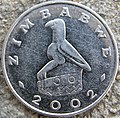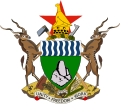Zimbabwe Bird: Difference between revisions
Flagmanbruce (talk | contribs) |
Flagmanbruce (talk | contribs) |
||
| Line 9: | Line 9: | ||
==On flags, currency and stamps== |
==On flags, currency and stamps== |
||
As the national symbol, images of the Zimbabwe Bird |
As the national symbol, images of the Zimbabwe Bird have appeared in various forms on the country's coat of arms, flags, currency, medals and stamps. |
||
<gallery> |
<gallery> |
||
Image:Flag of Zimbabwe.svg|National [[flag of Zimbabwe]] containing the Zimbabwe Bird. |
Image:Flag of Zimbabwe.svg|National [[flag of Zimbabwe]] containing the Zimbabwe Bird. |
||
Revision as of 20:24, 18 June 2016


The stone-carved Zimbabwe Bird is the national emblem of Zimbabwe, appearing on the national flags and coats of arms of both Zimbabwe and Rhodesia, as well as on banknotes and coins (first on Rhodesian pound and then Rhodesian dollar). It probably represents the bateleur eagle or the African fish eagle.[1][2]
Origins
The original carved birds are from the ruined city of Great Zimbabwe, which was built by ancestors of the Shona, starting in the 11th century and continuing for over 300 years.[3] The ruins, after which modern Zimbabwe was named, cover some 730 hectares (1,800 acres) and are the largest ancient stone construction in Zimbabwe. Among its notable elements are the soapstone bird sculptures, about 40 centimetres (16 inches) tall and standing on columns more than 90 cm (3 ft) tall, were installed on walls and monoliths of the ancient city of Great Zimbabwe.[3] They are believed to have been a sign of the royal presence.
After the ruins of Great Zimbabwe were discovered by European colonists in the late nineteenth century, they took five of the carved birds to the Cape Colony and sold them to its leader Cecil Rhodes. A German missionary came to own the pedestal of one bird, which he sold to the Ethnological Museum in Berlin in 1907.[4] In 1981, a year after the attainment of independence in Zimbabwe, the South African government returned four of the statues to the country; the fifth is held at Groote Schuur, Rhodes' former home in Cape Town. In 2003, the German museum returned the portion of bird's pedestal to Zimbabwe.[4]
On flags, currency and stamps
As the national symbol, images of the Zimbabwe Bird have appeared in various forms on the country's coat of arms, flags, currency, medals and stamps.
-
National flag of Zimbabwe containing the Zimbabwe Bird.
-
Flag of Zimbabwe Rhodesia (1979-1980).
-
Flag of Rhodesia (1968-1979).
-
Coat of Arms of Rhodesia (1924-1982).
-
Emblem used by the Rhodesia Corps of Signals (1970-1980).
-
Obverse side of a Rhodesian dollar note with Zimbabwe Bird in the bottom left hand corner.
-
Logo used by the Parliament of Rhodesia.
-
Rhodesian Grand Commander of the Legion of Merit (GCLM) medal (Civil and Military).
-
Reverse side of a Zimbabwean one dollar coin.
-
Reverse side of a Zimbabwe fifty dollar note (2nd series) illustrating the Great Zimbabwe Ruins and Zimbabwe Bird in the bottom right hand corner.
-
Zimbabwe 17c stamp (2nd definitive series).
-
Revenue stamps of Zimbabwe.
-
Zimbabwe Postage Due 2c stamp.
-
Coat of Arms of Zimbabwe (1982- ).
-
Flag of the Zimbabwe National Army.
-
Emblem of the Zimbabwe Prison Service.
-
Zimbabwe Air Force Chief of Staff Car and Aircraft car flag.
-
Flag of Harare, capital of Zimbabwe.
References and sources
- References
- ^ Thomas N. Huffman (1985). "The Soapstone Birds from Great Zimbabwe". African Arts. 18 (3): 68–73, 99–100. JSTOR 3336358.
- ^ Paul Sinclair (2001). "Review: The Soapstone Birds of Great Zimbabwe Symbols of a Nation by Edward Matenga". The South African Archaeological Bulletin. 56 (173/174): 105–106. JSTOR 3889033.
- ^ a b Great Zimbabwe (11th–15th century) | Thematic Essay | Timeline of Art History | The Metropolitan Museum of Art
- ^ a b "Zimbabwe bird 'flies' home", BBC, 4 May 2003, accessed 6 May 2013
















